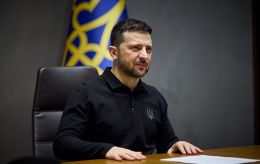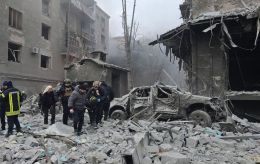Awaiting offensive: When Ukrainian Armed Forces will attack and what hinders them in 2024
 Photo: An expert predicts that in April 2025, the Ukrainian Armed Forces may conduct offensive (Getty Images)
Photo: An expert predicts that in April 2025, the Ukrainian Armed Forces may conduct offensive (Getty Images)
The NYT, citing Western officials, reported that Ukraine will not conduct a counteroffensive this year because the promised weaponry from allies is arriving slowly. However, it is not ruled out that the military might be ready to launch an attack in the fall, although weather factors could delay this timeline.
What the Ukrainian Armed Forces need, when the military might be ready for an offensive, and what is hindering it in 2024 are detailed in the material by RBC-Ukraine below.
Contents
- NYT wrote that "Ukraine would not be ready to launch a dramatic counteroffensive" this year
- Why it is important to distinguish between the concepts of counteroffensive and offensive
- The Ukrainian army will get a stream of new people no earlier than in the fall
- Guided bombs are one of the main problems on the front, and F-16s are the first step toward an offensive
- Weather factor and why an offensive might happen in 2025
NYT wrote that "Ukraine would not be ready to launch a dramatic counteroffensive" this year
The New York Times reported that Ukraine "would not be ready to launch a dramatic counteroffensive or retake large swaths of territory from Russia until next year." The agency cites two unnamed officials who note delays in the arrival of promised Western weaponry such as missiles, combat vehicles, ammunition, and air defense systems, which could take weeks to months to reach the front lines. Additionally, some of the announced weaponry has not yet been purchased or manufactured.
"A senior NATO official said the support would put Ukraine on a path toward being able to push back Russia next year, while Ukraine waits for more Western weapons to arrive and moves more of its troops to the front," the NYT quoted the source.
Separately, a senior Pentagon official mentioned that Ukrainian forces "would remain on the defensive for the next six months, but in a constant churn on the battlefield that would ultimately fail to gain significant ground".
American officials and analysts acknowledge that the battlefield situation "has changed significantly in the past several weeks", as about $61 billion in aid approved by the US Congress in May begins to strengthen Ukraine's defense. This aid has notably slowed the Russian forces in the Donetsk region and halted advances in the north of the Kharkiv region.
Why it is important to distinguish between the concepts of counteroffensive and offensive
Military expert Pavlo Narozhnyy emphasized the importance of distinguishing between the concepts of counteroffensive and offensive while commenting on the NYT publication.
"Let's imagine that we are, for example, in a settlement of Robotyne, where the enemy is rapidly advancing and pushing us out of positions but hasn't yet gained a foothold. And at this point, before the enemy gains a foothold, we conduct counteroffensive actions. This is precisely what a counteroffensive is when the enemy has not gained a foothold," Narozhnyy explained in a comment to RBC-Ukraine.
He pointed out that Russian forces are entrenched in positions where the Ukrainian Armed Forces might potentially conduct an offensive, some of which they have held for 1, 1.5, or even 2 years. And if we talk about an assault of such well-fortified positions, this is an offensive.
"They have consolidated very well there. And here we are talking about an offensive. We would be storming very well-fortified positions that the enemy knows very well and has already set up logistics. By the way, they are already building a railway along the Sea of Azov to supply weapons and so on," Narozhnyy noted.
The Ukrainian army will get a stream of new people no earlier than in the fall
The interlocutor also explains that in order to launch an offensive in a particular area of the front, a strike group must be formed. As an example, Narozhnyy says, we can recall Robotyno, where in the summer of 2023 the Ukrainian military managed to advance several tens of kilometers as part of an offensive.
"There was a grouping of 120,000 personnel there. Do we have such reserves now? President Volodymyr Zelenskyy said that we have 14 brigades that are not fully staffed. But he did not provide details. Let's imagine a situation where all these brigades sit in the rear, waiting for weapons. What are 14 brigades? One brigade is up to 5,000 people (according to open sources, up to 8,000 - ed.). And we don't know whether these are artillery, engineering, airborne assault, or separate mechanized brigades. Let's imagine that if they are all mechanized with tanks and artillery, then it is up to 100 thousand people at most," Narozhnyy admits.
In addition, the expert emphasizes that it should be understood that July is almost halfway through, which means that the summer campaign is crossing the "equator."
"The mobilization law came into effect on May 16. Afterward, the military conscription office received tools to call up more people, and a stream of people joined the army. Let us remember General Yurii Sodol (Yurii Sodol was dismissed from his position as Commander of the Joint Forces on June 24, 2024 - ed.), who spoke in the Rada (Ukrainian parliament - ed.) before the law was passed that in some units, where there should be ten people, there are only three to four, which is 30-40% of the personnel. So, at that time, there were not enough people in the army," recalls Narozhnyy.
He explains that people are now being mobilized to the army to fill this shortage, but these citizens must first undergo basic training.
"It takes 80 days to obtain a military specialty. Additionally, in most cases, they also receive specialized training. For example, a soldier may be a tank mechanic-driver who also needs to practice driving a tank. Afterward, they go to their military unit for coordination and to learn how to interact with their unit and others," says the expert.
Therefore, adding together 80 days of basic training + specialized training + coordination is 120 days.
"And so from May 16, we find ourselves in October when these individuals could be ready for combat. Of course, this is an idealized scenario. Some may be able to progress faster because they have military experience, but most have not been in the army and need to go through the entire process," Narozhnyy adds.
Therefore, the interlocutor explains that the flow of people into the military will only be in the autumn.
Guided bombs are one of the main problems on the front, and F-16s are the first step toward an offensive
"As for weapons, we all know how and in what batches they are delivered because most of this information is public. However, one of the major problems on the front is the enemy's use of guided bombs. They drop them in large quantities. An aerial bomb is a cheaper version of a cruise missile. A cruise missile costs several million dollars, while an aerial bomb costs several tens of thousands of dollars," emphasizes Narozhnyy.
According to him, until the problem with guided bombs is resolved, any talk of an offensive is futile because the enemy will massively destroy Ukrainian forces.
"When they are in defense, it is very difficult to destroy them, but when they carry out offensive actions and deploy large amounts of equipment in the fields, if the enemy can drop bombs, it will annihilate a large number of our troops. Therefore, the first step for our offensive is to obtain F-16s," says Narozhnyy.
He emphasizes that it's not about getting ten fighters but about fifty. This number would at least somewhat change the situation with guided bombs.
"We also need to get Patriot systems positioned not in rear cities but at the front to shoot down enemy aircraft dropping these bombs. Currently, we don't have F-16s, and Patriots are being transferred very sparingly, primarily for the defense of Kyiv and other Ukrainian cities. Mobilization is ongoing. Therefore, talking about an offensive this year is unrealistic," the expert believes.
Weather factor and why an offensive might happen in 2025
In addition to the aforementioned issues, there is also the weather factor. The expert explains that when the rains start in the fall, the ground will turn into mud, making it impossible to use heavy equipment.
"Self-propelled artillery units will not be able to move there, and even wheeled vehicles won't be able to travel through all that mud. Therefore, only next year. Only in the spring of 2025, around April at best. When the ground dries up, aircraft, new Patriots, and all the weapons arrive. And also, those who were mobilized will complete their training and coordination. So, theoretically, we will be able to advance in April. However, it's hard to make predictions," the expert concluded.
At the beginning of April 2024, President Volodymyr Zelenskyy stated that Ukraine had developed a plan for a new counteroffensive, but its implementation required Western assistance.
Later in July, the head of state reported that there were 14 brigades in the Ukrainian military that were understaffed. He explained that the difficulties were related to delays in the supply of weapons from partners and added that the problem could be resolved if there is a desire and the tools. He also stated that it was not possible to talk about counteroffensive actions because Ukraine needs to defend what it has.
Sources: interviews with President Volodymyr Zelenskyy for Bloomberg and Bild, material from The New York Times, and an exclusive comment from military expert Pavlo Narozhnyy.

